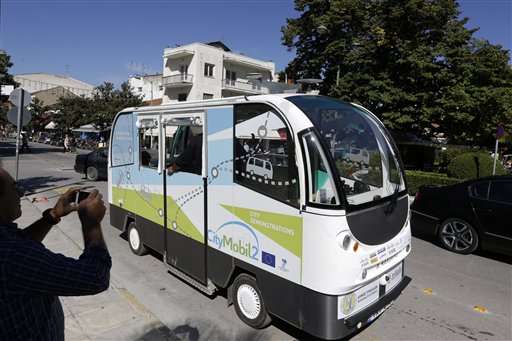

Greek commuters have a new way to get to work: a completely driverless bus that operates within normal traffic. The buses are part of a program that has been running in Trikala, Greece, since earlier this summer, but so far they’ve only been tested without passengers–up until last Saturday, that is. Now people will be able to use the buses to get around. The trip is completely free of charge, and could be safer and more efficient than buses driven by humans.
“It’s the first time someone dared to bring a totally automated vehicle into open traffic,” Angelos Amditis tells Popular Science. Amditis is the research director at Greece’s Institute of Communication and Computer Systems, which is handling the technical side of the project. Previously, automated vehicles in Greece were either operated only in segregated lanes or exhibition areas, or under the supervision of a professional driver in case of emergency. There’s no human backup for Trikala’s six automated buses, which operate surrounded by other cars, bicyclists, and pedestrians.
New laws had to be passed to make way for the project, and even so the buses operate under strict limitations. The maximum permitted speed is around 12 miles per hour. While other drivers can merge into its lane, a bus isn’t allowed to change lanes or make turns—it just drives a short circular route. And if there’s any obstacle in its path, it sits there and waits for the object to move. “We have to be strict,” says Amditis. When humans crash, it’s an accident, but a crash involving an automated vehicle would be a political mess, “even if there’s a hundred less accidents overall.”
This program is part of a European Union-funded project called CityMobil2, which aims to develop public transportation projects in medium-sized cities. There may not be enough users to justify a subway or full bus system, but commuters, the elderly, or people with limited mobility would benefit from the easy way to get around.
In densely populated cities like Manhattan or Paris, buses like these might work best with no humans behind the wheels at all. Amditis says smart vehicles work best when they can count on the smarts of other cars around them—no crazy, light-beating, lane-swerving, human stunts to throw off their calculations.
But he says most places will continue to have mixed traffic for a while. In the near future, fully automated cars may drive alongside cars with partial automation like the new Tesla as well as human-driven cars, pedestrians, and bikes. The bus program in Trikala will provide important information about how automated vehicles handle such diverse environments.
The buses will putter around Trikala until March 2016, at which point the assessment phase begins. Researchers will look at how the vehicles performed as well as the reaction of passengers, citizens, and city management. The current bus fleet, designed by Robosoft, is just for testing. If Trikala likes the program, they will have to get their own buses. Amditis says he hopes cities will exploit his research, producing more buses and implementing their own programs.
“It’s not just introducing a new type of bus,” he said, “but changing the whole system. It’s not a trivial thing.”